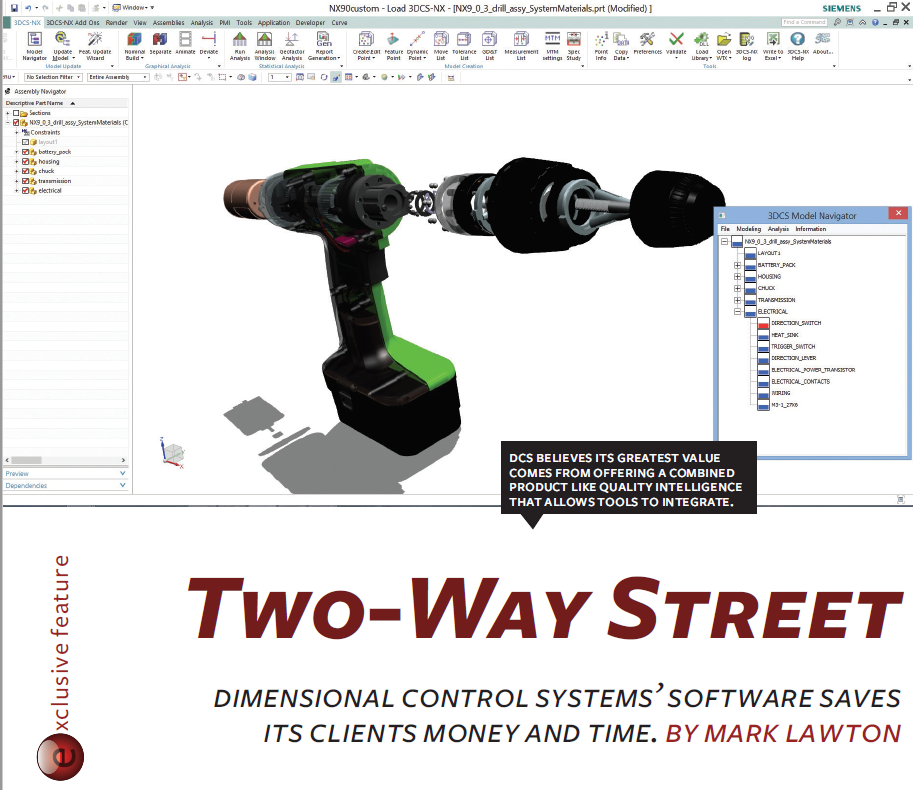
 Combining Simulation and Manufacturing Tools that utilize the digital twin helps design and production communicate efficiently and effectively, reducing overall costs.
Combining Simulation and Manufacturing Tools that utilize the digital twin helps design and production communicate efficiently and effectively, reducing overall costs.
As featured in Manufacturing Today:
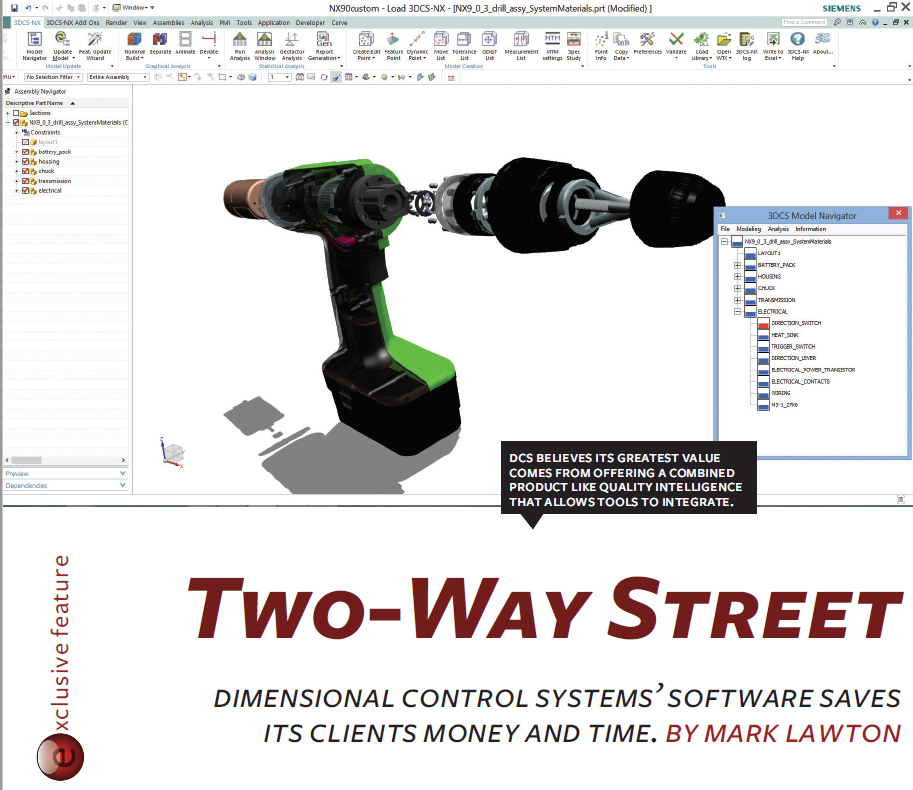
Manufacturing is most successful when the communication between design and production is a two-way street, allowing potential problems to be identified early. That is the benefit and goal of Quality Intelligence software. Quality Intelligence is a combination of multiple products that Dimensional
Control Systems (DCS) has traditionally promoted and delivered independently. While the company will continue to offer those products separately, DCS believes its greatest value comes from offering a combined product like Quality Intelligence where the different tools have the ability to integrate and talk to each other.
Quality Intelligence is a software platform created by DCS that has four major elements:
“The overall concept of Quality Intelligence is to centralize information and turn it into decision-making information,” Product Manager Thagu Vivek says.
Perhaps the greatest benefit to Quality Intelligence is its ability to connect production – those on the shop floor – with engineering.
“There has always been a need to connect those two,” Vice President of Sales Don Jasurda says. “We addressed that gap by creating this closed-loop product.”
Quality Intelligence helps with the problem of isolated or “over the wall” engineering. Vivek explains that when any product is designed, the designer has to make a lot of assumptions about accurateness, tolerance and other aspects. The product then goes to the shop floor to be manufactured.
“Now, the capabilities they have are really only known when you manufacture,” Vivek says. “If the design team knows the factors of the manufacturing floor up front, they can make a design more robust.”
Quality Intelligence helps by analyzing the capabilities of those manufacturing plants and feeding that information back to the design team so the product can be optimized. Think of it as a two-way street rather than a one-way street with information flowing back and forth between engineering and production.
“There are also the realities of what the companies might be capable of,” Jasurda says. “There might be limitations on capabilities that need to be considered.”
If engineers design a product that is impossible to manufacture given the capabilities of the plant, then designers and production teams could be at odds with each other. “If they have to purchase $10 million in manufacturing assembly equipment for production, that needs to be considered as part of the business case for the product [up front],rather than at the 11th hour saying ‘We really can’t produce this,’” Jasurda says. “The data to tell them the capacity is readily available in Quality Intelligence.”
“Because of our end-to-end solution from design to engineering, we can align model-based definition,” Vivek adds.
Model-based definition, sometimes called digital product definition,is the practice of using 3-D models within 3-D CAD software to define individual components and product assemblies. “Our tool set aligns very well,” Vivek says. “We start at the design level and connect to manufacturing.
The same information can be sent through the system without interruption or loss of information along the way.”
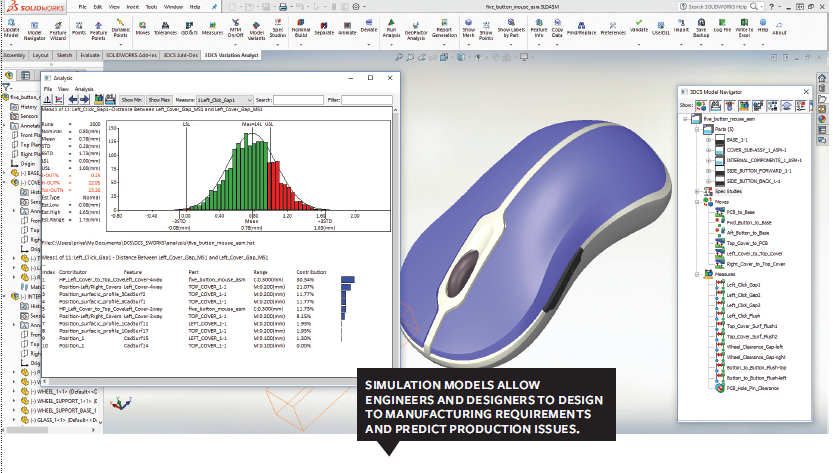
Quality Intelligence could be used in industrial machinery, oil and gas exploration, automotive, aerospace and other sectors. Manufacturers could benefit in a number of ways. One way is its predictive ability.
Quality Intelligence monitors inspection data from the plant floor and converts it to a dashboard that does predictive analysis, Vivek explains. “It predicts when the process is going to go out of control and can immediately alert” the user, he says. For example, imagine an assembly line that is making pins and the size of those pins are being examined for consistent size. If the size of the pins
change, Quality Intelligence can notify personnel.
Another benefit is how data is integrated across the process instead of machines and systems importing and exporting data.
“How we achieve all this is by centralizing the data that is coming into the system,” Vivek says. Centralizing data with Quality Intelligence creates a well of common data that different departments can dip into for different purposes. Inspection departments can receive work orders, report publishers can create web-based reports on demand, design and engineering teams can get data to improve products and quality engineers or managers can monitor production. Many simulation tools espouse the creation of a digital twin, a digital replica of a physical product. Quality Intelligence incorporates that information during the design phase and keeps that digital twin intact as the product moves through its lifecycle.
“From a quality perspective, what we’ve been doing with measurement data analysis and monitoring is really a digital twin of the quality process that has been going on for years,” Jasurda says. “It is now practical to do that with the plant,all their equipment, plant structure and layout. They want digital twins of everything to make effective use in the same way people have been using digital representations of quality results for years.
”Most other companies offer software that deal with one or two capabilities of Quality Intelligence. “[Quality Intelligence] has a focused capability and directness in being able to address the customer problems both quickly and efficiently,” Jasurda says. “Most solutions on the market are unwieldy and expensive to procure, deploy and maintain. Quality Intelligence, especially in the Cloud, is more practical for small and mid-size manufacturing companies.”
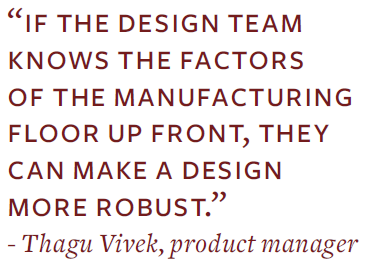
3DCS Variation Analyst, which is used by manufacturers to improve quality assurance and component design, is an important part of Quality Intelligence.
The technology uses Geometric Dimensioning and Tolerancing (GD&T), a language used in manufacturing to define and communicate engineering tolerances. GD&T can help manufacturers reduce scrap, rework and increase overall part quality. 3DCS Variation Analyst is used in various types of manufacturing including medical devices, electronics and machinery. Manufacturers in aerospace and automotive, in particular, use GD&T to frame rails, aircraft skins, fuselages and bodies. Using 3DCS Variation Analyst, those manufacturers can simulate part and process variation and then take actions to control and reduce the impact of variation.
3DCS is installed on a workstation or a company’s server. Functioning as a plug-in for the company’s existing 3-D CAD software, 3DCS adds key simulation and analysis to existing CAD models.
To facilitate this process, 3DCS technology is fully integrated within well-known CAD platforms including Dassault Systemes’ CATIA V5, 3DEXPERIENCE, and SOLIDWORKS, as well as Siemens NX and PTC CREO. Engineers and designers then have the ability to design to manufacturing requirements, produce validated GD&T for the plant and predict production issues with simulation models – all from within the CAD system they are familiar with.
Manufacturers using digital GD&T (PMI, FTA) can use the information to determine which tolerances are critical to their product and which are not. This allows them to loosen non-critical tolerances while still meeting their quality goals. Digital GD&T streamlines the manufacturing of parts by eliminating errors from the design release process by giving users better control of data. DCS also offers a multi-CAD version of 3DCS that functions as a standalone tool by importing CAD data. 3DCS Multi-CAD, like the integrated versions, uses embedded GD&T to simulate part variations and display potential issues in production.
“As the most advanced tolerance analysis tool in the market, 3DCS Variation Analyst offers users the ability to do more than just 3-D stack ups by analyzing the relationship between your parts and accounting fora multitude of sources of variation,”the company says. “This gives you the most accurate results to make important decisions about your design and manufacturing processes.”DCS updates the 3DCS technology annually based on feedback from customers. In addition, DCS offers monthly webinars and training opportunities for new and existing users.
DCS was started in 1995 by Bob Kaphengst and John Mathieson, both of whom formerly worked at General Motors. The company began working in the automotive industry, then moved into the position to help aircraft and aerospace companies and is now working with many electronics and medical device manufacturers. Today, DCS Quality Intelligence is used to analyze the assembly process of multi-component products before and during production to help optimize that process. The company’s software helps minimize wasted materials and excess time while validating assembly and manufacturing processes.
Perhaps most importantly, DCS software can find potential issues before manufacturing takes place, when issues are much cheaper to fix. Once production starts, unexpected errors can cost millions of dollars to remedy.In past years, engineers would develop prototypes of products. DCS software allows engineers to mostly eliminate the time and expense of building prototypes, a definite benefit for manufacturers as product life cycles have shrunk.
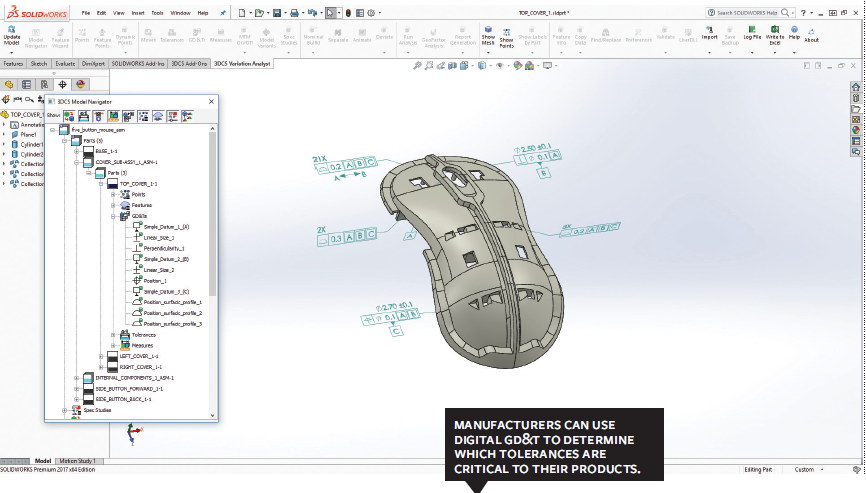
Among the company’s clients are leading manufacturers from around the globe. They include General Motors, BMW, Nissan, Sony, Airbus, Boeing, Lockheed Martin, Philips, Samsung, GE and Jaguar Land Rover.
These Stories on CATIA
No Comments Yet
Let us know what you think